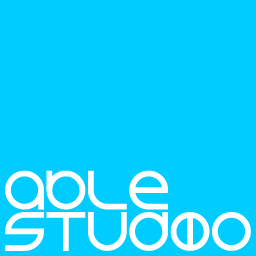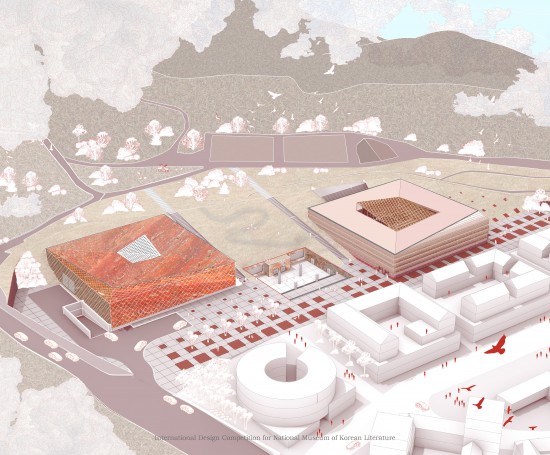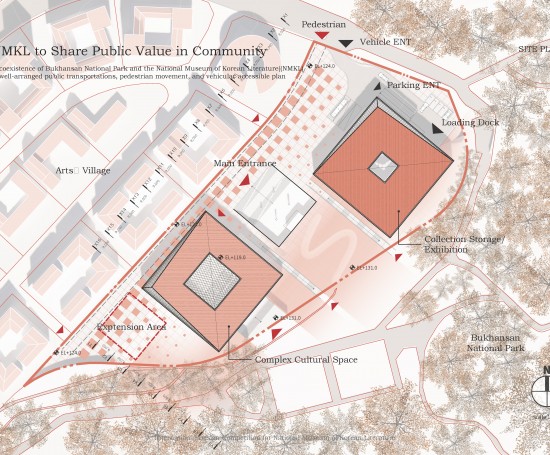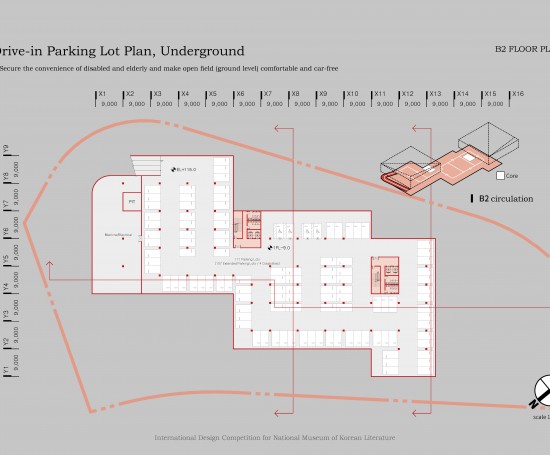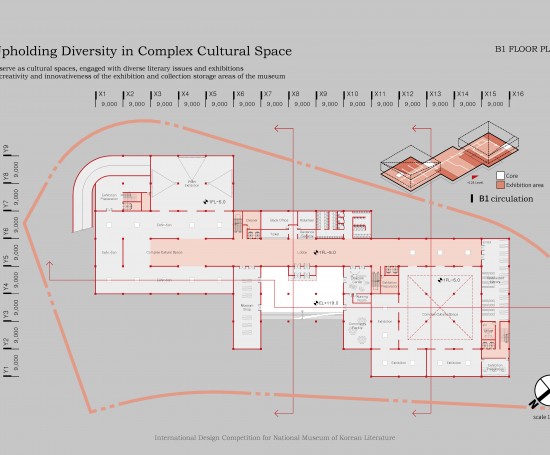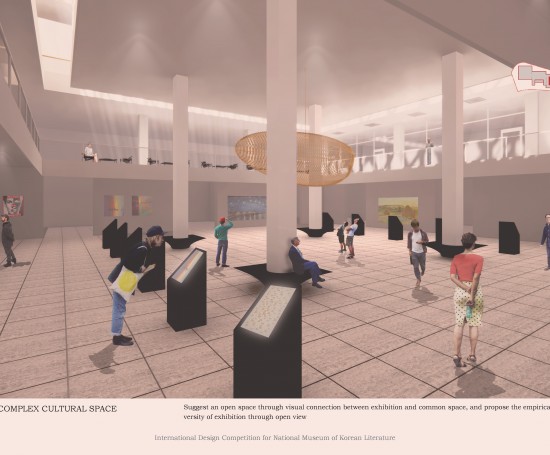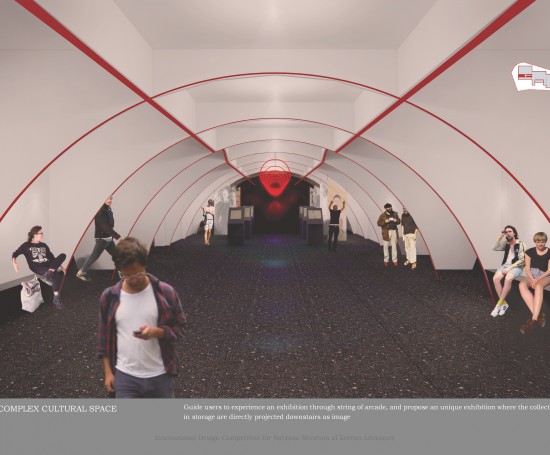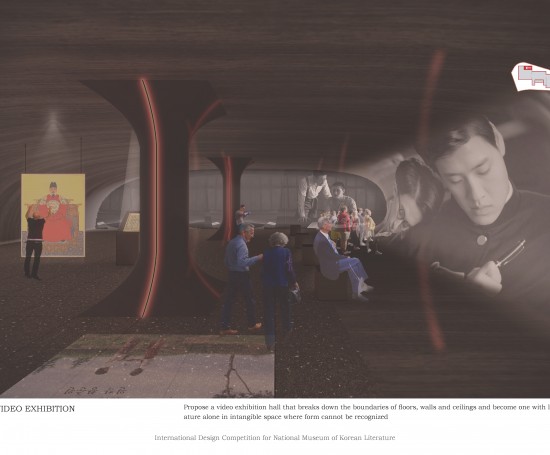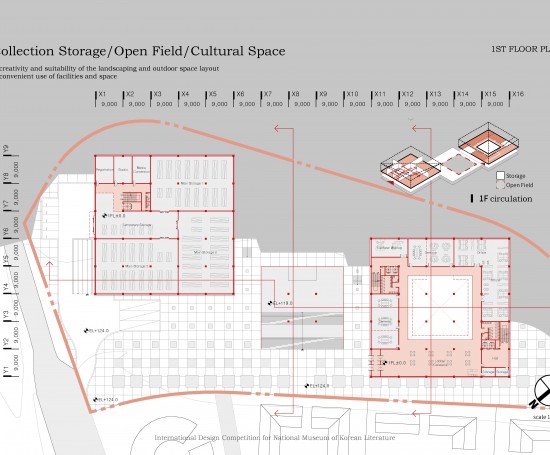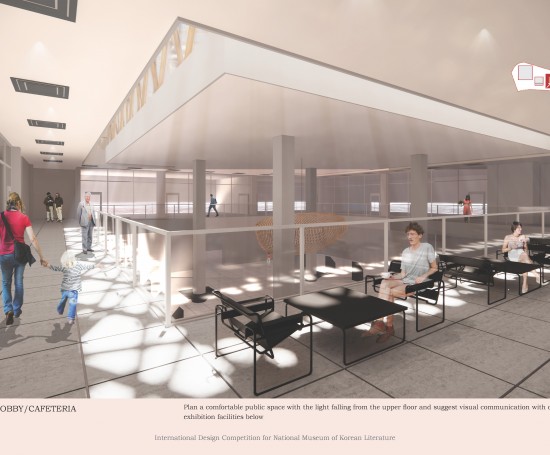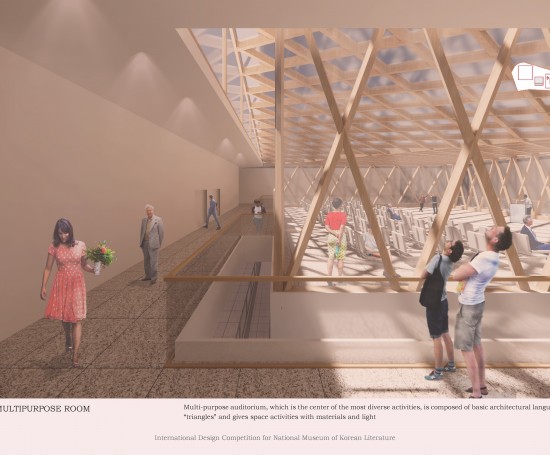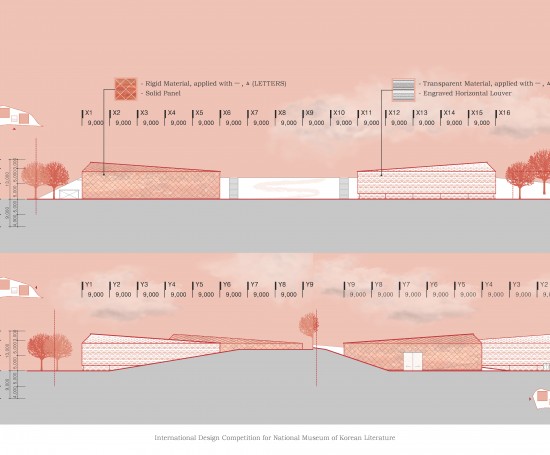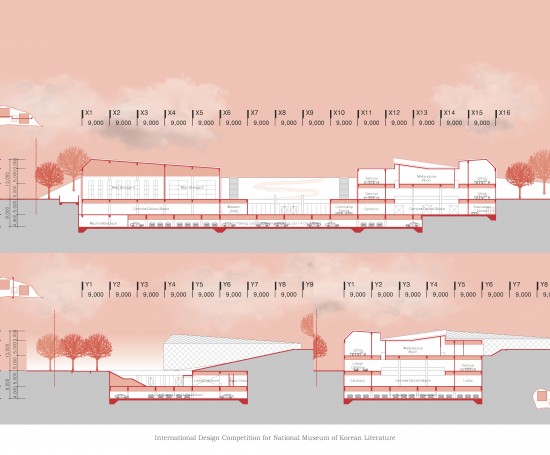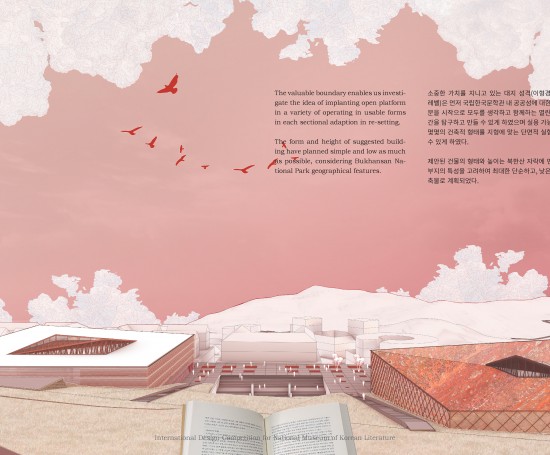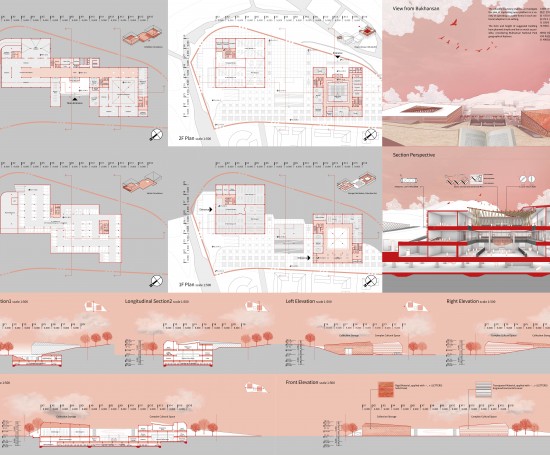National Museum of Korean Literature 국립한국문학관 건립 국제설계공모
TYPE: Competition
STATUS: Honorary Mentions (가작)
Partner in Charge: June Ho Kim, Huida Jeong
Project Team: Hyeong Geun Moon
ㆍㅡ ㅿㅁㅇ(LETTERS)
National Museum of Korean Literature
Preface
LITERATURE
Literature is the basis and start of all forms of art. It has been there with the long history of mankind as the most basic genre of art. Literature is the art with language as a medium of expression so that poetry, fiction, sijo, K-pop, Goryeo, lyrics, plays, reviews, essays, diaries, etc are various kinds of other genres, expressed in their own language. The Korean alphabet, known as “Hangul” expresses sounds with “consonants and vowels” and one syllable gathers to form words. The word again produces sentences within modern Hangul orthography. Literature is a world created by a series of these sentences. We are looking at literature as the basis of art FOAM, expressing our times.
문학은 모든 예술의 기초이자 출발로, 가장 기본적인 예술 장르로서 인류의 오랜 역사와 함께해 왔다. 문학은 언어를 표현 매개체로 ‘시, 소설, 시조, 가요, 고려가요, 가사, 희곡, 평론, 수필, 일기’ 등은 그들의 언어로 표현된 다양한 예술 장르이다. ‘한글’이라는 언어는 ’14 자음과 10모음’으로 소리를 표현하고 한 음절이 모여 단어를 만든다. 그 단어는 다시 근대식 철자법, 맞춤법 안에서 문장을 만들어 낸다. 문학은 이 문장들의 연속이 만들어낸 세상이다. 우리의 시대를 표현하는 기본의 예술적 틀로서 한국 문학을 바라본다.
ARCHITECTURAL LANGUAGE
Architecture has always been there through the long history of mankind as the basic tool of life. At the beginning, shelter, the least space for mankind, is to ensure safety from the natural environment. From the moment, architect has been extracting basic spatial languages in forms; ‘Walls, columns, floors, corridors, stairs’ are the basic elements and prerequisites in space.
In terms of using own language and having great values in the formation, literature and architecture have similar partial structures. Architectural design begins with languages of basic elements and geometries such as dots, lines, and faces in which we define them as one of the consonants and vowels of Hangul.
Through several structural adjustments, the combination of language becomes a refined building. This valuable process and clearest space in the formation of architecture might symbolize literature itself.
건축은 모든 삶의 기초이자 출발로, 가장 기본적인 삶의 도구로서 인류의 오랜 역사와 함께해 왔다. 인류 최소의 공간을 생각해보자, 인간은 자연환경으로부터 자신의 안전을 보장받기 위해 피난처를 본능적으로 구축해왔으며 이로부터, 이때부터 건축가들은 기본적인 공간의 언어(벽, 기둥, 바닥, 복도, 계단)들을 추출해 왔다.
언어 사용과 가치형성 측면에서, 문학과 건축은 유사한 구조를 지니고 있다. 건축은 ‘점, 선, 면’과 같은 기본 ‘도형언어’에서 시작하며 그 조합들은 몇몇의 구조적 조정을 거쳐 정제된 건물이 된다. 이러한 형성가치의 과정들은 문학 그 자체를 상징할 수 있는 가장 명확한 공간일 것이다.
Regional Connectivity
SURROUNDINGS
The site is located at the west side of Bukhansan National Park and in Eunpyeong New Town which has cultural facilities as cluster. Well connected with transportation infrastructures from other capital area of Seoul, it is adjacent to Arts Village, where the life, culture, and arts co-exist, depending on the district unit planning in the future. Also, given boundary has spread around Gijachon Neighborhood Park(기자촌 근린공원) and Bukhansan Dulle-gil courses that are stretched south and east of the site.
공모 대상지는 북한산국립공원 서쪽 자락과 주변에 풍부한 문학적 클러스터 (사비나미술관, 기독교박물관, 통일 박물관, 이호철 문학관) 가 형성되어 있는 은평 뉴타운 내 위치해 있다.
우수한 교통 인프라(지하철 3, 6호선, GTX, 신분당선)를 중심으로 서울 도심과 서북부 주거지역(은평뉴타운)으로부터 접근성이 우수하며 삶과 문화 예술이 공존하는 예술마을(예정)과 맞닿아 있다.
또한 대상지의 경계는 남동쪽 북한산 둘레길 및 기자촌 근린공원과도 밀접한 연계성으로 풍요로운 자연 환경적 조건을 가지고 있다.
Where is Public Value in space?
PUBLICITY
Our starting point is to answer and figure out the openness and public value altogether with National Museum of Korean Literature’s innovative building and its creative inner space. To secure an architectural publicness is mainly considered “being balanced” as top priority. It faces significant challenges in making a balanced use of the site and in responding to current surroundings and future change.
The definition and answer to ‘what is publicness?’ is applied public square(domain), in the middle, that allows neighbor and visitors access to the site from Art Village, Gijachon Neighborhood Park and Bukhansan Dulle-gil courses.
In our proposal, a grid system is directly projected into the contour for unity of spatial continuity from level +124. This beginning framework allows us to implant open platforms for executing ground reallocation as “being balanced” with public square, storage building and complex cultural space. Within the condition, the main entrance of complex cultural space is being placed below on a contour where gives us an encircling open field for outdoor concerts and events.
먼저 국립한국문학관의 건물 형태와 그 내부의 혁신적인 공간개념과 더불어 대지내에 공공성 및 공공 가치에 대한 질문과 그에 대한 답(방향)이 우리 계획안의 출발점이다.
주어진 대지 내 외부공간과 건축물의 배치 속에서 전체적인 건축공간의 공공성을 확보하기 위해서는 균형이 우선시되어야 한다. 이는 땅에 대한 균형적인 사용과 동시에 주변 맥락(예술마을, 북한산공원)을 고려하여 건축공간의 공공성을 확보하기 위함이다.
우선 현재의 물리적 상황(예술마을 보행로/북한산 둘레 길 높이차이) 및 풍부한 자연환경)과 주변 상황(문학적 클러스터)을 존중하여 계획 방향을 설정하였으며 가까운 미래의 변화될 모습을 고려하며 접근하였다.
주어진 과제 중 “열린 시대의 공공성은 무엇인가?” 에 대한 정의 및 그에 대한 답으로 대지를 균형 있게 사용하며 주민에게 개방되고 소통되는 중앙 광장을 만들고 및 예술마을(예정) 보행로에서 접근할 수 있는 작은 소로들을 만들어 연결하는 것으로 시작하였다. 이 광장(Public Value, Public Domain)은 주민과 문학관을 찾는 이용자들의 소통이 이루어지는 공간으로 활용되며 새롭게 공공공간을 제시는 하는 방법이라 할 수 있다.
본 계획안은 공간의 연속성 및 통일성을 위하여 무형의 그리드 시스템을 대지에 투영하였다. 이러한 공간체계는 수장고 및 복합문화시설과의 균형적 사용을 위한 열린광장을 우선적으로 뿌리내리게 하였다. 이러한 상황속에서 복합문화시설의 주출입구는 중앙 광장을 지나 위요 된 지면아래 썬큰 공간을 통하여 진입하도록 유도하였다.
Remark
The valuable boundary enables us investigate the idea of implanting open platform in a variety of operating in usable forms in each sectional adaption in re-setting. The form and height of suggested building have planned simple and low as much as possible, considering Bukhansan National Park geographical features.
소중한 가치를 지니고 있는 대지 성격(이형경계, 레벨)은 먼저 국립한국문학관 내 공공성에 대한 질문을 시작으로 모두를 생각하고 함께하는 열린 공간을 탐구하고 만들 수 있게 하였으며 실용 가능한 몇몇의 건축적 형태를 지형에 맞는 단면적 실험할 수 있게 하였다. 제안된 건물의 형태와 높이는 북한산 자락에 면한 부지의 특성을 고려하여 최대한 단순하고, 낮은 건축물로 계획되었다.
